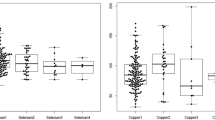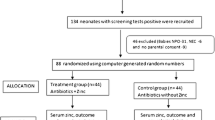Abstract
The aim of this study is to explore the prognostic value of blood zinc, iron, and copper levels in critically ill neonates by comparing blood metal levels with the score for neonatal acute physiology (SNAP). Forty-six neonates (26 boys, 20 girls; ages ranging from 10 min to 23 days) who had been admitted to the neonatal intensive care unit of hospital and who were critically ill according to SNAP were included. Another 15 neonates (12 boys, 8 girls; ages ranging from 30 min to 24 days) who were brought to the hospital for a health checkup were included as controls. Clinical data, time in the intensive care unit, prognosis, and SNAP for critically ill neonates were recorded. Blood Cu, Zn, and Fe values were measured by inductively coupled plasma atomic emission spectrophotometry. Ill neonates were divided into extremely critical (SNAP ≥10) and critical groups (1 ≤ SNAP < 9). Zn levels were lower in patients than in controls (p <0.05). Cu levels did not differ between patients and controls (p >0.05). Fe levels were not significantly between the critical and control groups (p >0.05). In ill neonates, blood Zn and Fe concentrations in the extremely critical group were lower than in the critical group (p <0.05). Serious illness in neonates may lead to decreased Zn and Fe blood concentrations. Zn and Fe supplements may be beneficial for critically ill children.
Similar content being viewed by others
References
Engelgau M, Rosenhouse S, El-Saharty S et al (2011) The economic effect of noncommunicable diseases on households and nations: a review of existing evidence. J Health Commun 16:75–81, Review
Von Dessauer B, Bongain J, Molina V (2011) Oxidative stress as a novel target in pediatric sepsis management. J Crit Care 26:103, e1-7
Costa GA, Delgado AF, Ferraro A et al (2010) Application of the pediatric risk of mortality (PRISM) score and determination of mortality risk factors in a tertiary pediatric intensive care unit. Clinics (Sao Paulo) 65:1087–1092
Lim L, Rozycki HJ (2008) Postnatal SNAP-II scores in neonatal intensive care unit patients: relationship to sepsis, necrotizing enterocolitis, and death. J Matern Fetal Neonatal Med 21:415–419
Chunchao H, Junhua Y, Yingzi W et al (2006) Hypoglycemic activity of fermented mushroom of Coprinus comatus rich in vanadium. J Trace Elem Med Biol 20:191–196
Han C (2009) Comparison of anti-hyperglycemic effect of inorganic constituents and organic in traditional Chinese medicine, Jinqi compound recipe. Biol Trace Elem Res 131:55–61
Kalkan Ucar S, Coker M, Sözmen E et al (2010) An association among iron, copper, zinc, and selenium, and antioxidative status in dyslipidemic pediatric patients with glycogen storage disease types IA and III. J Trace Elem Med Biol 24:42–45
Wang BH, Yu XJ, Wang D et al (2007) Alterations of trace elements (Zn, Se, Cu, Fe) and related metalloenzymes in rabbit blood after severe trauma. J Trace Elem Med Biol 21:102–107
Wang G, Lai X, Yu X et al (2012) Altered levels of trace elements in acute lung injury after severe trauma. Biol Trace Elem Res 147:28–35
Saaka M, Oosthuizen J, Beatty S (2011) Effect of joint iron and zinc supplementation on malarial infection and anaemia. East Afr J Public Health 6:55–62
Bard H (1993) Assessing neonatal risk: CRIB vs SNAP. Lancet K 342:449–450
Maiya PP, Nagashree S, Shaik MS (2001) Role of score for neonatal acute physiology (SNAP) in predicting neonatal mortality. Indian J Pediatr 68:829–834
Thiele DJ (2003) Integrating trace element metabolism from the cell to the whole organism. J Nutr 133:1579S–1580S
Guo CH, Liu PJ, Lin KP (2012) Nutritional supplement therapy improves oxidative stress, immune response, pulmonary function, and quality of life in allergic asthma patients: an open-label pilot study. Altern Med Rev 17:42–56
Lambert J, Agostoni C, Elmadfa I (2004) Dietary intake and nutritional status of children and adolescents in Europe. Br J Nutr 92:S147–S211
Al-Saleh E, Nandakumaran M, Al-Shammari M, Al-Falah F, Al-Harouny A (2004) Assessment of maternal-fetal status of some essential trace elements in pregnant women in late gestation: relationship with birth weight and placental weight. J Matern Fetal Neonatal Med 16:9–14
Artym J (2008) The role of lactoferrin in the iron metabolism. Part I. Effect of lactoferrin on intake, transport and iron storage. Postepy Hig Med Dosw (Online) 62:599–612
Stephanie S (2010) Trace elements. Curr Anaesth Crit Care 21:44–48
Acknowledgments
This work was supported by grants from the National Natural Science Foundation Council of China (No. 30772458 & 81072508) and the National Science & Technology Pillar Program (No. 2012BAK02B02).
Source of support
This work was supported by grants from the National Natural Science Foundation Council of China (No. 30772458 & 81072508) and the National Science & Technology Pillar Program (No. 2012BAK02B02).
Author information
Authors and Affiliations
Corresponding authors
Rights and permissions
About this article
Cite this article
Wang, G., Wang, D., Jiang, X. et al. Blood Zinc, Iron, and Copper Levels in Critically Ill Neonates. Biol Trace Elem Res 164, 8–11 (2015). https://doi.org/10.1007/s12011-014-0193-3
Received:
Accepted:
Published:
Issue Date:
DOI: https://doi.org/10.1007/s12011-014-0193-3




